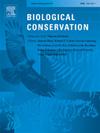鸟类国际生命协会海鸟跟踪数据库:海洋保护合作 20 年
IF 4.9
1区 环境科学与生态学
Q1 BIODIVERSITY CONSERVATION
引用次数: 0
摘要
鸟类生命海鸟追踪数据库(STDB)成立于 2004 年,旨在整理追踪数据,以解决海鸟在渔业中意外死亡的问题,并帮助确定与建立海洋保护区相关的海上地点。经过 20 年的发展,STDB 已拥有来自 450 个繁殖地的 168 个物种的约 3,900 万个地点。通过与科学界的持续合作,STDB 已成为支持海洋保护的有力工具,有助于汇编可靠的多物种数据,以解决大范围的问题。科学、技术和数据 库促进了重大的海洋保护成果,包括指定了第一个完全利用跟踪数据确定的海洋保护区。基于海鸟与渔业之间重叠的分析所做的宣传,促使区域渔业管理组织采取了减少海鸟误捕的措施。STDB 还为海洋中的洄游连通性提供了令人信服的证据,并在为许多政策工具提供信息方面发挥了至关重要的作用,这些政策工具的范围从国家(如保护和管理根据跟踪数据确定的重要地点)到区域(如与区域公约合作),再到全球(如确定具有生态或生物重要意义的海洋区域)。本综述概述了:1)海鸟跟踪数据库是如何起步和发展的;2)其在数据覆盖面和差距方面的现状;3)方法论方面的发展;4)保护方面的成功经验;5)管理这一全球数据库所经历的机遇和挑战;6)海鸟跟踪研究的优先研究事项和未来方向。本文章由计算机程序翻译,如有差异,请以英文原文为准。
The BirdLife Seabird Tracking Database: 20 years of collaboration for marine conservation
The BirdLife Seabird Tracking Database (STDB) was established in 2004 to collate tracking data to address the incidental mortality of seabirds in fisheries and to contribute to identification of sites at sea relevant to establishment of Marine Protected Areas. After 20 years, the STDB has grown to hold ca. 39 million locations for 168 species from >450 breeding sites. The STDB has become a powerful tool to support marine conservation by facilitating the compilation of robust multi-species data to address broad-scale questions, made possible by continuous collaboration with the scientific community. The STDB has facilitated major marine conservation outcomes, including the designation of the first marine protected area to be identified solely using tracking data. Advocacy based on analyses demonstrating overlaps between seabirds and fisheries have led to the adoption of seabird-bycatch mitigation measures by Regional Fisheries Management Organizations. The STDB has also provided compelling evidence for migratory connectivity in the ocean, and been crucial in informing many policy instruments at scales from national (e.g. protection and management of important sites identified from tracking data), to regional (e.g. working with Regional Conventions), to global (e.g. the identification of Ecologically or Biologically Significant Marine Areas). This review presents an overview of 1) how the STDB started and gained traction, 2) its current status in terms of data coverage and gaps, 3) methodological developments, 4) conservation successes, 5) the opportunities and challenges experienced in managing this global database, and 6) research priorities and future directions for seabird tracking studies.
求助全文
通过发布文献求助,成功后即可免费获取论文全文。
去求助
来源期刊

Biological Conservation
环境科学-环境科学
CiteScore
10.20
自引率
3.40%
发文量
295
审稿时长
61 days
期刊介绍:
Biological Conservation is an international leading journal in the discipline of conservation biology. The journal publishes articles spanning a diverse range of fields that contribute to the biological, sociological, and economic dimensions of conservation and natural resource management. The primary aim of Biological Conservation is the publication of high-quality papers that advance the science and practice of conservation, or which demonstrate the application of conservation principles for natural resource management and policy. Therefore it will be of interest to a broad international readership.
 求助内容:
求助内容: 应助结果提醒方式:
应助结果提醒方式:


